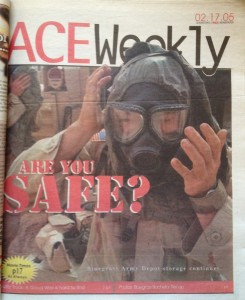Ace coverstory February 17, 2004
BY CAMPBELL WOOD
The Pentagon has proposed budget changes for 2006 which would delay the destruction of 523 tons of chemical weapons stored at the Blue Grass Army Depot 

This is contrary to Congress’s stated emphasis on accelerating the destruction of these deteriorating weapons after September 11. The proposed delay, estimated at five to 10 years, would cause the U.S. to fail to fulfill its commitment under the international Chemical Weapons Convention, which sets 2012 as the deadline for destruction of the weapons. The Pentagon is also considering transportation of chemical weapons across state lines for incineration in distant states. These revelations came from Pentagon internal documents acquired and released by the Chemical Weapons Working Group (CWWG), based in Berea.
According to CWWG director, Craig Williams, “Kentucky and Colorado are being used as ‘bill-payers’ for huge cost overruns at other disposal facilities, particularly those using incineration. In addition, with neutralization demonstrating its superior destruction and safety capabilities there’s the real possibility that incineration advocates want to see this technology killed, as it would inhibit their ability to push incineration on the world market.”
“No process is perfect,” adds Williams. “The fundamental difference between the two approaches is the level of control operators have over the material during processing. Neutralization is a low temperature, low air velocity process which is very controllable. Incineration is high temperature, high air velocity process with an exhaust stack at the other end. These incinerators have a history of releasing agent and chronically emitting heavy metals, dioxins, furans, and other carcinogens. Neutralization eliminates such health threats.”
The Budget Quagmire
A document dated December 21, 2004, an Acquisition Decision Memorandum, signed by Department of Defense Acquisition, Technology & Logistics Under Secretary Michael Wynne, questions the design readiness of neutralization for the disposal of chemical weapons. Under the Assembled Chemical Weapons Assessment (ACWA) program instituted by the Army in 1997 to study alternative technologies for the destruction of chemical weapons, neutralization was demonstrated and proven effective, accepted by scientists, endorsed by the Army and certified by Congress. Neutralization has already been in use at Aberdeen Proving Ground, Maryland, where the program to destroy chemical warfare agents in bulk containers is near completion. A neutralization facility at Newport Chemical Activity, Indiana, will begin operating soon. Strong opposition to incineration of chemical weapons in Colorado and Kentucky brought about the decision to use neutralization followed by super critical water oxygenation in Kentucky and biotreatment in Colorado. Operations and budgets at the four chemical weapons incinerators in Oregon, Utah, Arkansas and Alabama remain intact. These incinerators have been plagued with technical problems, chemical releases, shut downs, and budget overruns.


These severe funding cuts have halted construction and design in Colorado. Bechtel Parsons Blue Grass, the contractor handling the planned facility construction in Richmond, stopped hiring and suspended all bids in early January until matters are clarified. It took a 19 year battle carried out via public forums, scientific research and intense politics for the Blue Grass to replace the Army’s proposed incineration with neutralization. The decision to use neutralization in Kentucky was made by the Army in 2003. Design has been underway and construction was to begin soon.
“After the time and energy I have expended on ensuring these weapons are disposed of in a safe and environmentally friendly manner, I am personally insulted by the Department’s efforts to delay destruction and its suggestion of transporting the weapons elsewhere,” said Senator Mitch McConnell in a lengthy statement he issued.
Both Ben Chandler and Jim Bunning have sent letters to the Department of Defense urging that no budget cuts or delays hinder the planned schedule to destroy the chemical weapons in Richmond.
The January 16 Lexington Herald-Leader published a strong editorial decrying the Pentagon’s proposed setback for the Blue Grass Army Depot. As a symbol of protest, the Richmond City Commission has passed an ordinance that would make it a crime to transport chemical weapons within the city limits.
Seven of the eight states with chemical weapon storage sites have joined to block interstate transport of the weapons. Senators and House Representatives from both sides of the aisle in Colorado and Kentucky introduced a bill to derail the Pentagon’s transportation study. Senators from Alabama, Oregon, Maryland, Utah, and Indiana are also cosponsors. More senators from other states may sign on.
Doug Hindman of Berea was one of the many residents of Madison County shocked to learn in 1984 that the Army had stores of chemical weapons at the Blue Grass Depot. It had been a well kept secret. He attended the public meeting at which Army officials announced to a full house its plans to incinerate the weapons. From that meeting sprung the opposition to the incineration plan. A retired EKU psychology professor, Hindman is now Chair of the Citizen’s Advisory Commission (CAC), created by Congress in 1991 with its members appointed by the governor. “It’s disappointing to have the funding pulled at this late date,” said Hindman. “All these years the CAC has worked very hard to bring about a consensus among the local citizens, the state and federal government to eliminate these weapons of mass destruction as quickly and safely as possible.
Risky Business
Continued storage of the chemical weapons in Richmond comes with increasing risk. Williams said that a 2002 classified report to Congress by the Secretary of the Army indicated Kentucky will be the chemical weapons stockpile site at the highest risk for terrorism after 2007. The deterioration and instability of the stored chemical weapons have long been a concern. Some of them have been stored there for over 50 years.
The weapons include 69,449 M-55 rockets containing GB (sarin) and VX nerve agents and 32,285 projectile rounds loaded with GB, VX or HD (mustard). The almost seven-foot long M-55 rocket contains 10 pounds of either VX or GB nerve agent. Each rocket also contains M28 propellant, which degrades over time through a series of chemical reactions that generate heat—heat that could build and cause autoignition. A chemical stabilizer added to the propellant at the time of manufacture helps control the chemical reactions and heat. However, the stabilizer itself is subject to degradation, which means that eventually autoignition is possible. Army analysis has concluded that the rockets are not in imminent danger of autoignition. However, lightning strikes or earthquakes could cause autoignition. Another problem is with leakage from aging munitions. The Depot has rigorous security and a daily routine of monitoring the stored weapons. This is obviously no picnic for the men and women who serve at the Depot. One can only wonder about how the commanders and soldiers at the base feel about the proposed delay (military personnel rarely go on the record with reservations about policy).
That the Pentagon has proposed to study transportation of the weapons is a surprising development, given that the Army had already reached conclusions on the matter after exhaustive studies.
In a Record of Decision in 1988, the former Undersecretary of the Army, James Ambrose, spelled out the reasons why the Army had ruled out transporting chemical weapons in favor of on-site destruction. He noted that catastrophic events are a constant concern at installations and the surrounding communities. By keeping the destruction process at the sites of storage, that concern would be absent from transportation corridors. “It is more important, in my judgment,” stated Ambrose, “to note the vastly more complex security, emergency response, and safety requirements associated with a transportation option and our much greater ability to control those same requirements at fixed installations… Compared to the on-site disposal alternative, any alternative that requires shipment of agent and munitions to other sites for disposal would be accompanied by handling risks, chance of transportation accidents, and threat of terrorist activities, which in turn increase public health and safety risks.” In his conclusion, Ambrose emphatically stated: “…no stockpile agents or munitions will be transported to other storage installations or sites for destruction. The Army will construct disposal facilities specific to each installation’s inventory of lethal chemical agents and munitions.”
Gulf War Syndrome Connection


At a CWWG conference Tuite read from a letter he had received in 1994 from a sick Gulf War veteran:
“We had gas alarms go off several times,” Tuite read aloud. “We were told they were all false alarms. We noticed what we thought were missiles streaking across the sky. We were told these were shooting stars. We heard loud explosions in the sky and saw bright flashes of light. We were told these were sonic booms.”
“That veteran is now suffering from Gulf War syndrome,” Tuite said.
When Tuite began his investigation in 1994, the Pentagon was reporting zero troops potentially exposed to chemical warfare agents during the Gulf War. An array of disease symptoms exhibited by a growing number of troops was dismissed as stress related. In 1996 the Pentagon acknowledged that as many as 500 troops may have been exposed to chemical weapons. In 1997 that number rose to 100,000; then 134,000 in 2000. In 2002, the Pentagon acknowledged as many as 140,000 troops may have been exposed to chemical warfare agents.
“We have documents that show that the Department of Defense (DOD) purposely manipulated their data,” said Steve Robinson, Executive Director of the National Gulf War Resources Center.
Robinson says an investigation by the General Accounting Office (GAO) found the DOD studies flawed. Based on GAO studies, Robinson said that as many as 400,000 troops may have been exposed to chemical agents. In a report available online the GAO states that the DOD’s “models were not fully developed for analyzing long-range dispersion of CW agents as an environmental hazard.”
In 1997, using U.S. government satellite photos of the Persian Gulf area during the 1st Gulf War along with meteorological data and apparent exposure of U.S. troops to low levels of chemical agents, Tuite created a map of the eight chemical storage sites in the U.S. The map shows circled territory around each site that would be potentially endangered in the event of a catastrophic event causing the release of chemical agent into the atmosphere. The danger of exposure to any area would be contingent on many variables, such as the nature of the incident, the quantity of agents released, and meteorological conditions, such as wind direction, cloud cover and so on. The circle around Richmond includes all of Kentucky and reaches into 10 other states.
“The very same individuals who misled Congress about the exposure of our veterans to chemical warfare agents, and who are associated with withholding vital information that delayed research into their exposures, are telling U.S. civilians that incineration and low level exposure to many of the very same compounds is safe,” said Tuite.
Gulf War Syndrome is a complex matter. Troops were exposed to an array of toxins. These included chemical weapons agents dispersed by U.S. bombing of Iraqi munitions and possibly other sites where chemical weapons had been deployed by the Iraq military and possibly by direct chemical weapon attacks by Iraq forces. Another exposure was to depleted uranium, a controversy being revisited in the current occupation of Iraq. The air was polluted by burning oil fields. Some troops may also have been adversely effected by PB pills (pyridostigmnine bromide), which were meant to protect GIs from one type of nerve gas in the Iraq arsenal.
Sarin is the chemical warfare agent that has received the most attention in the epidemiological investigations of Gulf War Syndrome.
During the initial bombing of Iraq during the first Gulf War, U.S., Czech, French and British forces all had chemical weapons detection systems that on numerous occasions went into alarm mode. A number of these alarms specified the presence of sarin.
Early bombing in that campaign struck Khamisiyeh, an Iraq munitions storage site. After the war, U.N. inspectors found evidence that chemical weapons had been stored at Khamisiyeh, and they included munitions loaded with sarin. Sarin does not readily burn, as do other chemical warfare agents. Tuite’s studies, supported by U.S. Air Force weather reports and satellite imagery, put forth the scenario that sarin had risen in a gaseous plume into the upper atmosphere where weather conditions directed it right over where hundreds of thousands of U.S. troops were stationed. Cloud cover and other meteorological conditions held the sarin in that general area. Heavier than air, the sarin precipitated from the atmosphere onto the troops.
The exposure would have ranged from low to lethal. At the time—this would be the period of January 17 through January 24 of 1991—many soldiers complained of a range of symptoms, which became dubbed the “Saudi Flu.” Tuite’s basic scenario became accepted, but various models applied to the events resulted in different estimates regarding troop exposure.
In his reporting Tuite gave a listing of the common symptoms suffered by those with GWS. Not all of the screened veterans had all of the symptoms, but most had a majority of them, said Tuite. Those symptoms included “recurring severe headaches; fatigue or weakness; joint and muscle pain; memory loss or difficulty concentrating; recurring rashes; lumps at joint areas and under the skin; depression; irritability; night sweats; insomnia; urinary urgency and frequency; diarrhea, sometimes bloody, or constipation; gastrointestinal disorders; dizziness or blackouts; blurry vision; photosensitivity; shortness of breath; coughing; abnormal hair loss; bleeding gums; abnormal liver functions; chest pains; sinus infections; and tremors.” There were also reported cases of cancers, blood diseases and various other disorders.
Researchers found the symptoms of GWS to be the same as those suffered by illness brought on by the sarin attacks in the subways of Tokyo in 1995. GWS symptoms have also matched the ones of sickened pesticide workers. Jerry Buccafusco, Professor of Pharmacology and Toxicology at Medical College of Georgia reported that “many of the symptoms reported by agricultural workers who had been subjected to repeated low-level intoxication are similar to those reported by Gulf War Veterans.”
Of the 697,000 troops deployed to the Persian Gulf during the first Gulf War, 342,265 have filed claims for disabilities. 303,884 of those claims have been processed, and 268,685 have been approved. The Veterans Administration does not keep statistics on the nature of those claims. U.S. troops are not alone in this. Soldiers from Australia, Canada, the Czech Republic, France, Norway, and Great Britain have also come forward claiming similar illnesses. Iraqis also had reported high rates of birth defects and numerous disorders including of the nervous system. Tuite also reported that tens of thousands of large mammals (camels, goats, and sheep), as well as birds and insects were killed by the environmental conditions.
Back to the Bluegrass
The Gulf War Syndrome shows the nature of the danger in our midst here in the Blue Grass. The Blue Grass Army Depot needs to get rid of these weapons. It’s not fair to prolong the situation which keeps the military personnel at Blue Grass Army Depot exposed to the danger. The continued storage of the weapons there pose a growing and far reaching, not a diminishing and locally bound, danger to the communities of all creatures around the Depot.
Craig Williams has spent twenty years active in this matter. It’s been his working life for the past 15 years.
He sees Mitch McConnell as a key figure at this point in history. As Senate Majority Whip and as a long term member of the Senate Defense Appropriations Committee, he’s vested with a good deal of clout. “Senator McConnell has promised to use every measure at his disposal to ensure that the weapons stored in Kentucky are destroyed in a timely manner,” Williams said. “He has stated his determination to resolve this funding crisis.”
The Herald-Leader reported earlier this week the fact that the Pentagon has “on hand enough money to keep work going for the next couple years,” but that it’s been lost amid the controversy—while “the Pentagon has impounded more than $400 million” in funds appropriated by Congress, the decision-makers for military spending, for neutralization plants in nearby Madison County, and in Colorado. n
BioChem 101
Sarin belongs to the family of toxic nerve agents known as organaphosphates. VX, also stored at the Blue Grass Depot, is an organaphosphate. Organaphosphates are widely used as insecticides and pesticides. The soldiers in the first Gulf War also doused themselves with organaphosphate insecticide to ward off the desert fleas. The effects of low level exposure to sarin and the effects of multiple low level toxic exposures over time became a subject of scientific inquiry. Scientists concluded that repeated low level exposures to sarin and/or other organaphosphates could lead to diseased states. This of course highlights a concern for the agricultural communities that surround some of the chemical weapons stockpiles in the U.S.
After years of studying Gulf War Syndrome, epidemiologist Dr. Robert Haley at the University of Texas Southwestern Medical Center in Dallas established that a significant number of Gulf War veterans had returned with something that was more than stress induced: brain damage. He concluded that exposure to sarin was a chief cause. Haley’s research has also revealed why some GIs became ill and others didn’t, and the reason is genetic. Some GIs were gifted with a gene that produces a certain enzyme, type Q paraoxonase, which fights off sarin. Actually the enzyme is very specific in combatting sarin, the nerve agent soman, as well as the common pesticide diazinon. For those that lacked the protective enzyme, sarin damaged deep structures in the brain damaging the parasympathetic nervous system, which Haley describes as the controller of all ongoing unconscious functions in the body.
The National Medical Institute under the national Academy of Sciences concluded that brain damage or neurological disease can be caused by exposures to low level or non-lethal amounts of sarin, and the symptoms may emerge sometime after initial exposures. The delayed toxic effects of chemical warfare agents had been documented well before the Gulf War.
James J. Tuite, III, was Interdisciplinary Sciences Director for the Chronic Illness Research Foundation, stated, “…other nations, including Iraq and the former Soviet states, acknowledge that repeated exposure to even very low levels of chemical warfare agents can result in serious physiological damage.”
Another scientist who studied Gulf War Syndrome was Howard B. Urnovitz, Ph.D, who got his doctorate in microbiology and immunology at the University of Michigan. Urnovitz found that chronic diseases are caused not by germs, but by “junk DNA,” those strands of DNA that have been regarded as useless excesses of DNA material. “What we learned by simultaneously studying GWS, cancer, AIDS and multiple sclerosis is that the genes have the ability to ‘reshuffle’ and create new genes. We reason that these new genes are used to adapt to the toxic environment in which we live. It seems that there are confounding events that turns this reshuffling mechanism from a normal protective process to a disease state.” Urnovitz suggests that like the mapping of the normal human genome, a mapping of the “detours” taken by the human genome under toxic exposure and chronic disease can be accomplished. He sees such mapping as a potentially useful tool for medical diagnosis and treatment.
YOU MIGHT ALSO LIKE
Richmond’s Nerve Gas Nightmare Ace September 1994
The Chemical Arsenal at Blue Grass Army Depot Ace September 1994










